|
Monday 26th September
to Sunday 2nd October 2022 |
| |
|
On Monday 26th it's the turn of Jupiter to be
at opposition, when it will be at its brightest with an apparent magnitude
of -2.8. If you go outside just after dark, Jupiter will have risen above
the horizon a little south of due east. Looking further south, Saturn will
be there shining at a magnitude of around +0.5 which is very confusing as
Jupiter will be the brighter of the two! When I did maths at school +0.5
was bigger than -2.8 so what's going on? |
| |
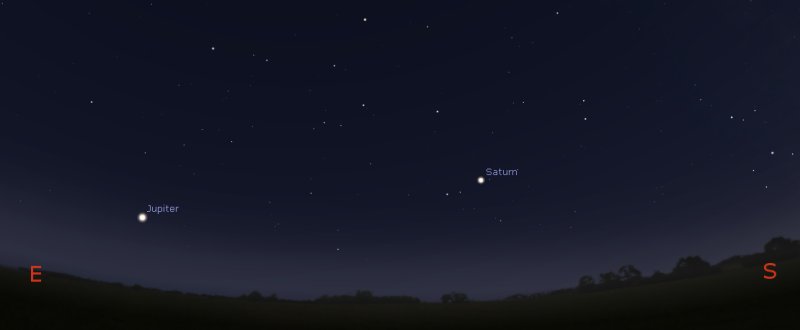 |
| |
|
The apparent magnitude scale works back to
front and the brighter an object is, then the more negative its magnitude
figure will be. The brightest star in the night sky, Sirius, has a
magnitude of -1.4 and a Full Moon is around -12.9 or in other words, much
brighter. From a dark sky location with the naked eye, it is possible to
see objects down to a magnitude of around +6. Binoculars will enable you to
see slightly fainter objects down to a magnitude of +8. Any dimmer than
that is "telescope territory". To put that into context, our own Sun has an
apparent magnitude of -26 which is why you never look at it through a
telescope! |
| |
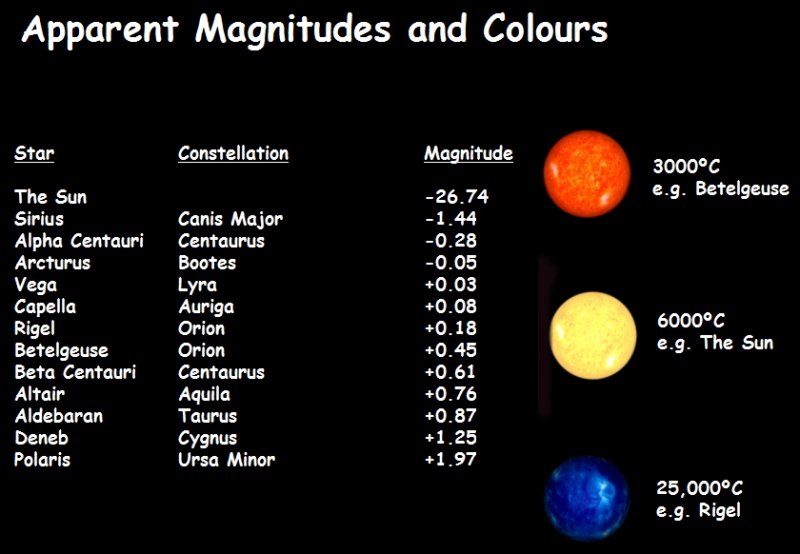 |
| |
|
I'm often asked how much my telescopes
magnify things, but that is not really the correct question! The question
should be regarding how much light the telescope collects - the larger the
aperture (or the bigger the hole in the front) then the more light the
telescope can collect. Once as much light as possible has been collected,
then the magnification is a function of the eyepiece. |
| |
|
To learn more about this, why not come along
to one of my Stars Over Somerset lectures at Ham Hill on 21st October and
18th November. |
| |
|
Details are on the
Latest News page. |
|
Monday 19th to Sunday
25th September 2022 |
| |
|
It's a quiet week on the astronomy front. Of
course the stars will all be there to see, along with the usual favourite
planets Jupiter and Saturn and a thin Crescent Moon. So in the absence of
anything more unusual to report, I'm going to take the opportunity to
advertise two astronomy lectures and star parties that I have scheduled in
partnership with Radio Ninesprings at the Ham Hill Visitor Centre. |
| |
|
The dates for your diary are Friday 21st
October and Friday 18th November from 7 to 9pm. |
| |
|
On both evenings, there will be a talk on
general astronomy and observing tips, lasting about an hour and then after
some refreshments, we will be heading outside to conduct our own little
adventure into space. The Moon will not be visible, so that gives us an
un-polluted view of the Andromeda Galaxy 2.5 million light years away and
the planets Jupiter and Saturn. Towards the end of the viewing session,
Mars and the Pleiades cluster of stars will be appearing over the horizon,
followed by the Great Orion Nebula. |
| |
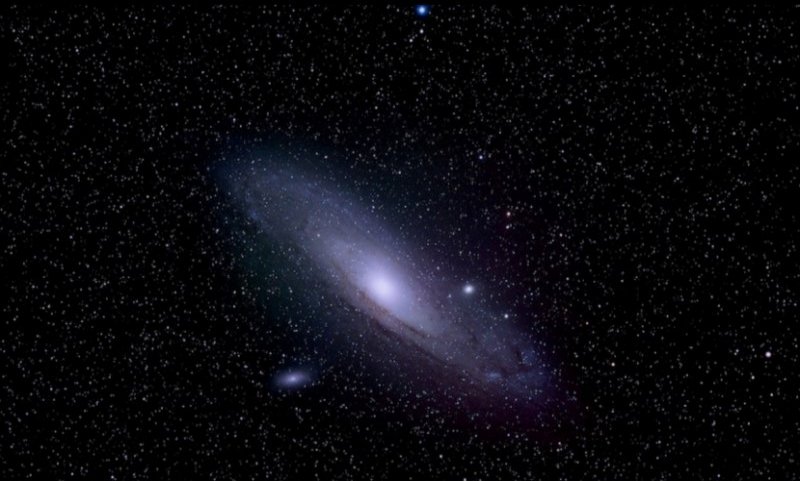 |
| |
|
Our “special guest” for the evening will be a
large piece of the Campo del Cielo meteorite that crashed into Argentina
over 4000 years ago! |
| |
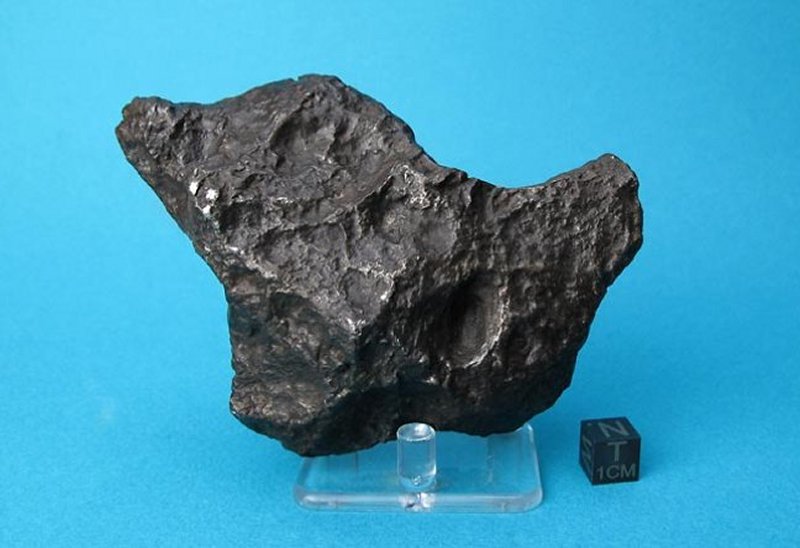 |
| |
|
The events are suitable for all the family
and the cost is £7 per adult, with a reduced rate of £3.50 for children
under 18 years of age. Booking is essential as places are limited.
Bookings can be made online via the
www.visitsouthsomerset.com website under the Ham Hill tab. |
| |
|
The actual use of the telescopes will be
dependent on there being clear skies each evening, but don't worry as I have
a "Plan B" if the weather isn't co-operating! |
| |
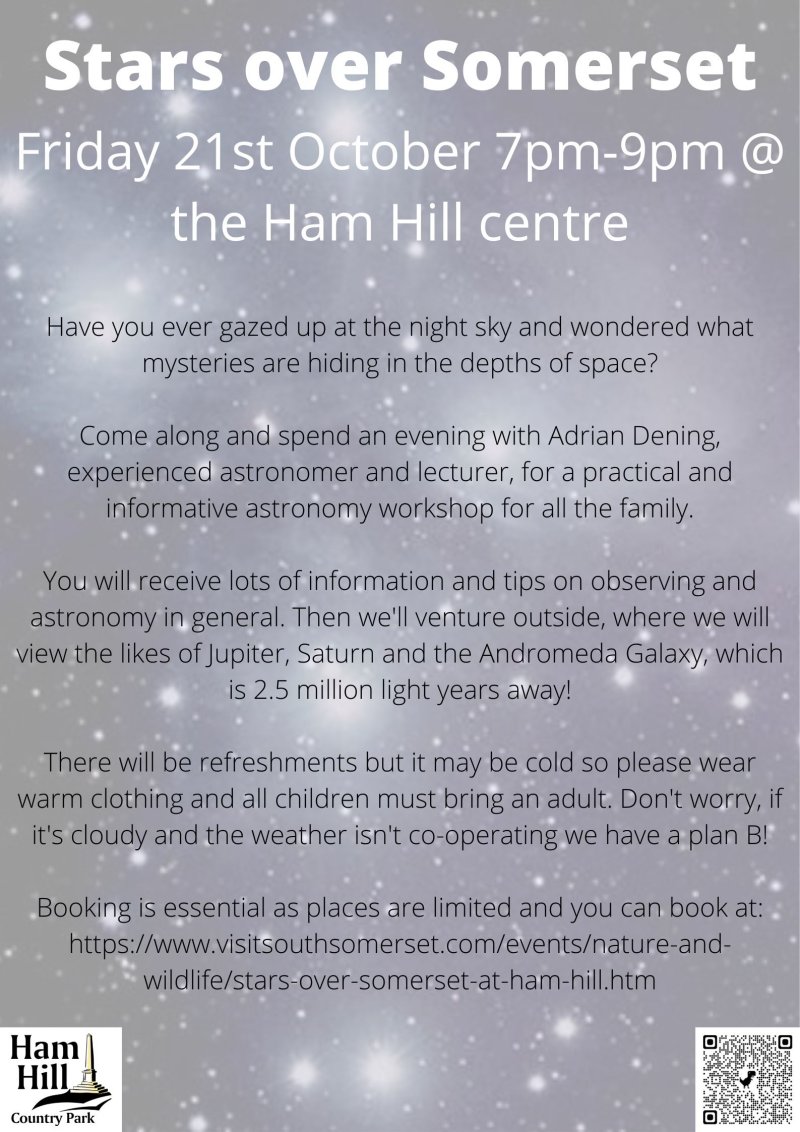 |
| |
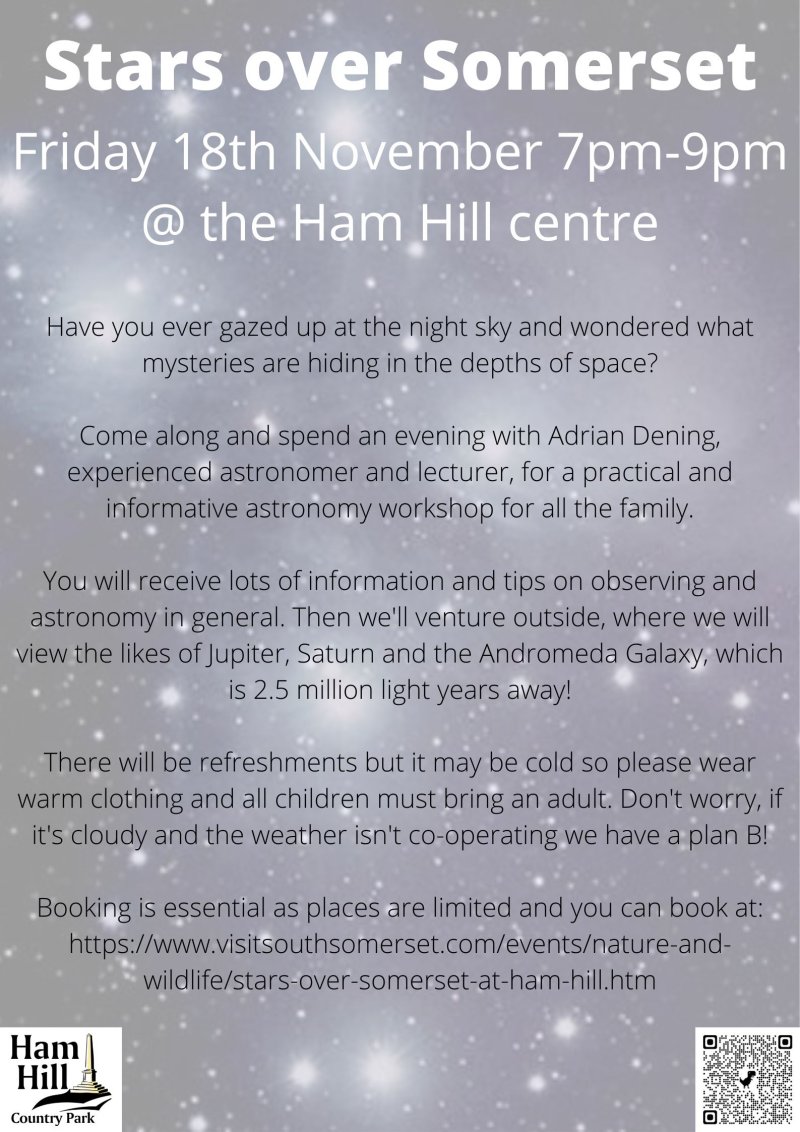 |
|
Monday 12th to Sunday
18th September 2022 |
| |
|
It's a week for observing the four gas giant
planets - Jupiter, Saturn, Uranus and Neptune - that live in the outer part
of our Solar System. All the observations can be made just after dark, so
no late nights are required! |
| |
|
On the evening of Wednesday 14th, a rare
event known as a Lunar occultation occurs where the Moon appears to pass in
front of the planet Uranus, blocking the gas giant from view for around
fifty minutes. |
| |
|
Look to the east at 10pm and you will find a
77%-lit waning Gibbous Moon with Uranus slightly to the left of it. The gas
giant will have a magnitude of around +5.7 so you will need binoculars or a
small telescope. As the bright leading edge of the Moon, or to use the
correct technical term, leading limb approaches Uranus, it will take about 8
seconds for the gas giant to disappear behind it. Fifty minutes later,
Uranus will appear again from behind the Moon's dark following limb to the
right. |
| |
 |
| |
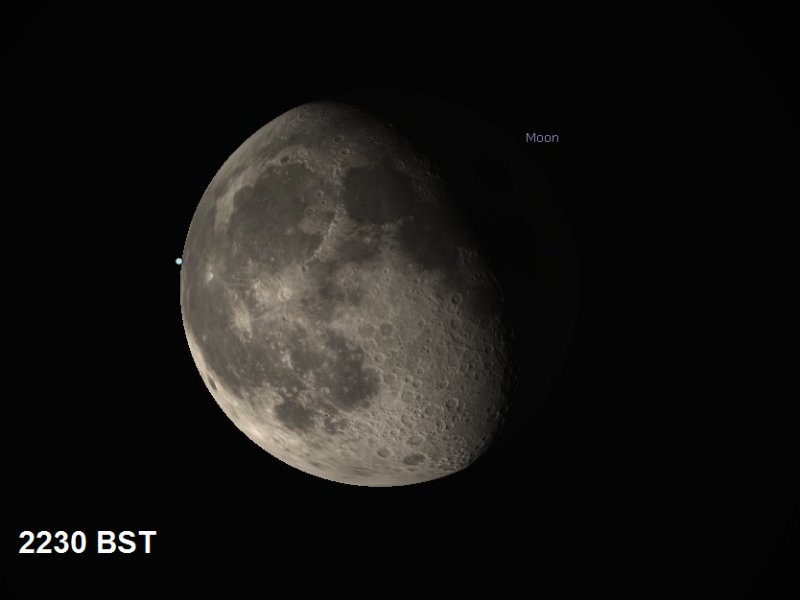 |
| |
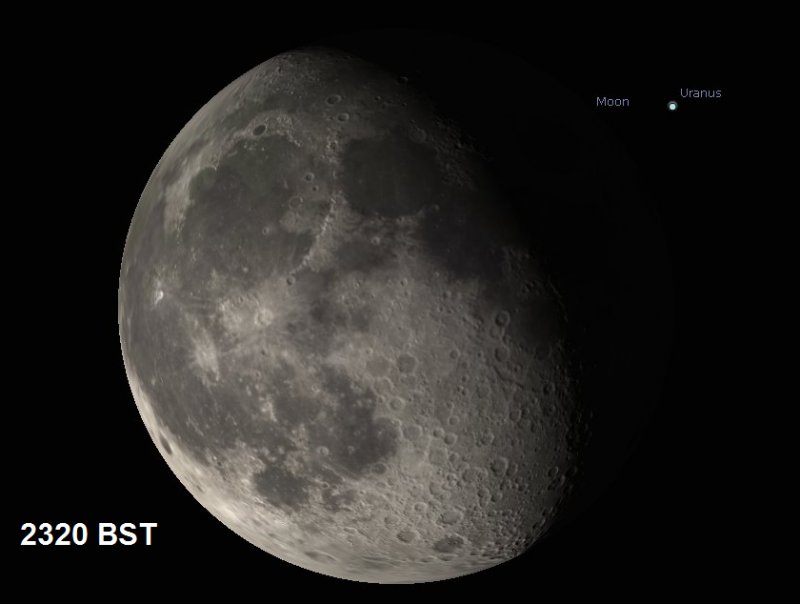 |
| |
|
On Friday 16th, Neptune is at opposition, so
it will be at its brightest around a magnitude of +7.8 If you go outside
around 10pm and look towards the south east, Jupiter will be a little to the
left and Saturn will be to the right. Above Jupiter is the constellation of
Pisces and at the right hand end of Pisces is the shape or "asterism" known
as the Circlet because it resembles a circle of stars. Neptune is below the
Circlet. Again, you will need a telescope because of the planet's
magnitude. |
| |
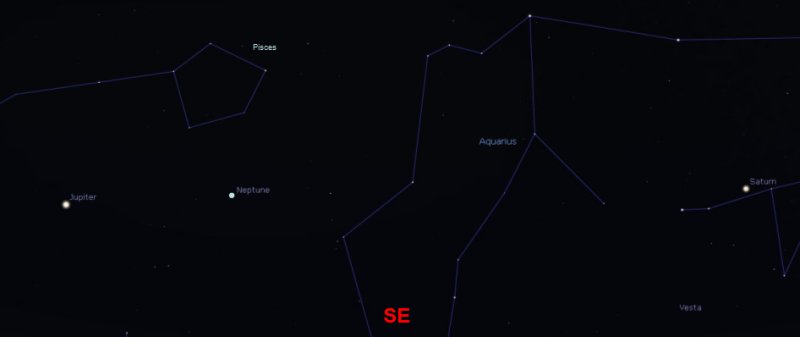 |
|
Monday 5th to Sunday
11th September 2022 |
| |
|
If you fancy a bit of a challenge and don't
mind an early start around 4.30am, there is an opportunity on Thursday 8th
to spot minor planet 3 Juno that lives in the Asteroid Belt and the gas
giant Neptune. 3 Juno will be at opposition, or in other words, the
brightest it gets at a magnitude of +7.8. Neptune will have a similar
magnitude so you will need to dig out that telescope to see them. A Gibbous
Moon will have already set in the west, so no light pollution to spoil your
view. |
| |
|
Look towards the south west and find
Jupiter. Our pair of targets form a line running down from Jupiter at an
angle of about 5 o'clock. Neptune is a little below the constellation of
Pisces and 3 Juno is above Aquarius. |
| |
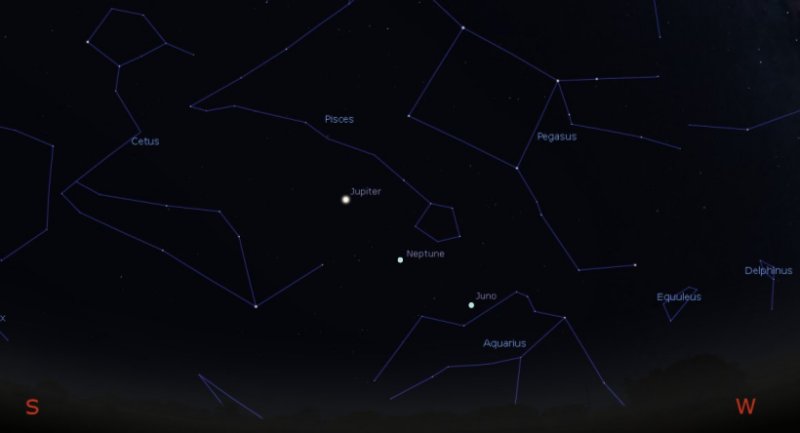 |
| |
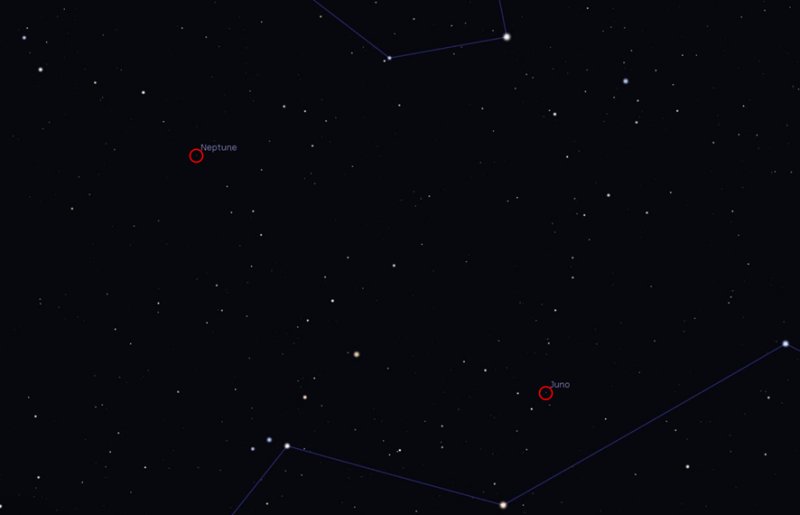 |
| |
|
On Saturday 10th, a Full Moon rises above the
horizon to the east just as it gets dark. This Full Moon is the closest one
to the Autumn Equinox when we have equal periods of light and dark, so is
called a Harvest Moon. |
| |
|
The Autumn Equinox occurs on September 23rd
and on that day, the Earth's tilt of 23.5 degrees is side-ways on to the
Sun. The Sun also appears to rise due east that morning and sets due west
in the evening. If you were on the Equator, the Sun would be directly
overhead at midday. |
| |
|
While looking at the Moon, you could also
take a look at Jupiter to the left of it and Saturn to the right, but the
bright Sunlight reflecting off the lunar surface will spoil the contrast
somewhat. |
| |
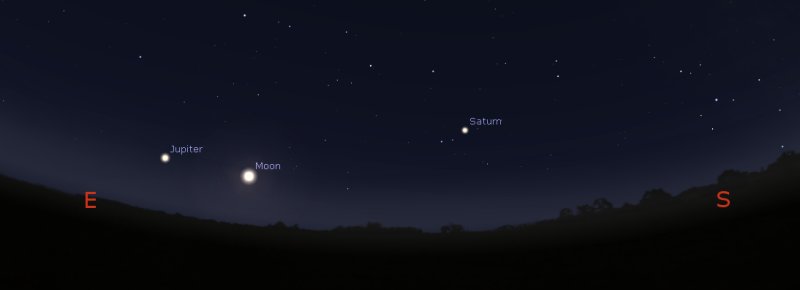 |
|
Monday 29th August
to Sunday 4th September 2022 |
| |
|
If you go outside a little after dark, say
from 10pm, the Moon will have already dropped below the horizon to the west
and so will be producing zero light pollution - a favourite time for
astronomers who want to go hunting deep sky objects - those faint fuzzy
blobs. |
| |
|
I like to classify deep sky objects into
three different types - clusters of stars (either globular or open
clusters), nebulas (or collections of gasses) and finally galaxies. The
clusters and nebulas are relatively close to us, within our own Milky Way
galaxy, where the neighbouring galaxies are millions of light years away,
far outside the Milky Way. Of course if you could get up close to one of
those galaxies, you would see that it contains billions of stars along with
clusters and nebulas of its own. |
| |
|
If you look towards the east south east, find
the constellation of Pegasus. To the left of Pegasus is the next closest
galaxy to us, the spiral shaped Andromeda Galaxy M31. It is quite an easy
target to find with your telescope despite being a whopping two and a half
million light years away from us! When you look at it, you are seeing the
galaxy how it was 2.5 million years ago as the light has taken that long to
reach us! From a very dark location it is even possible to make it out with
the naked eye. |
| |
|
Alternatively, to the right of Pegasus is a
12 billion year old globular star cluster, catalogued by Charles Messier
while he was comet-hunting and given the designator M15. A small telescope
will reveal a definite glow or fuzzy blob; a larger telescope will show a
bright core with a halo of surrounding stars. It is only 35,000 light years
away from us- in other words, well within our Milky Way. |
| |
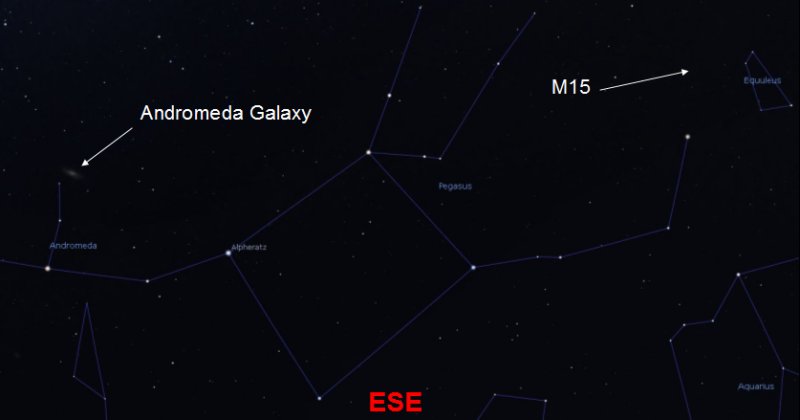 |
| |
 |
|
Monday 22nd to
Sunday 28th August 2022 |
| |
|
A couple of weeks ago I mentioned that Saturn
was at opposition which meant that its rings would be at their brightest.
Next week, on Tuesday 23rd, it's the turn of minor planet 4 Vesta to reach
opposition and it should have a magnitude of around +6.0. This makes it an
easy target for binoculars or a small telescope or even the naked eye from a
dark sky location. |
| |
|
4 Vesta is the second largest lump of rock in
the Asteroid Belt, only beaten by the dwarf planet Ceres. The "4" signifies
that it was the 4th minor planet discovered, back in 1807. It is the
brightest asteroid visible from Earth and has a diameter of only 525Km or a
little over 300 miles. Vesta's name comes from Roman mythology - the
goddess of home and hearth. |
| |
|
So where will it be and how do you find it?
If you are outside from 10pm local time, our old friend Saturn will be
towards the south east and Jupiter will have just risen above the horizon to
the east. If you are in a nice dark location, you might be able to make out
the faint cloud of the Milky Way stretching from the southern horizon up
towards the bright star Altair. |
| |
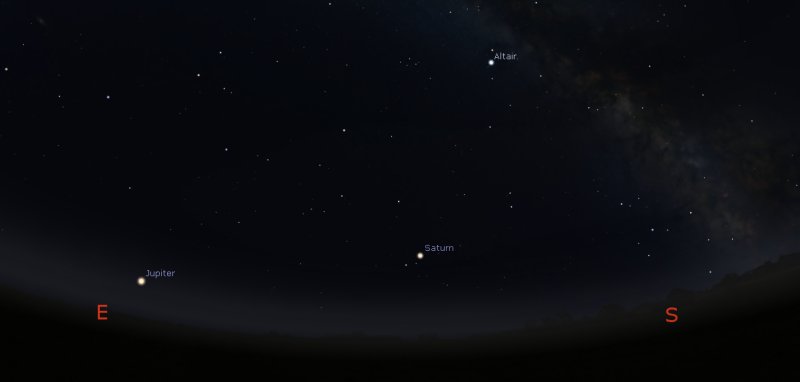 |
| |
|
Anyway.....back to 4 Vesta.....the minor
planet is located a little down and to the left of Saturn. I have included
a star chart below to help you locate it - the trick is to use the patterns
of stars on the chart to judge its approximate position. |
| |
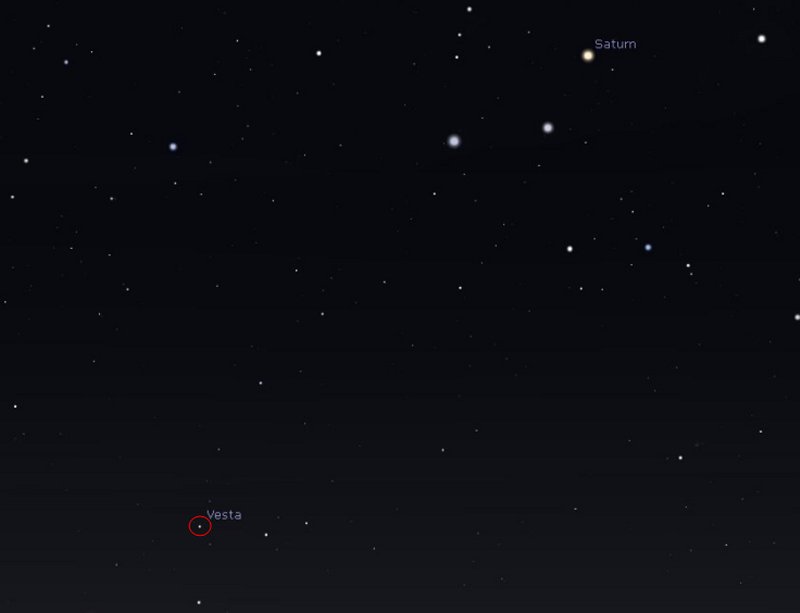 |
| |
|
Finally, some advance notice that I have
organised a couple of astronomy lectures and star parties at Ham Hill
Country Park for the evenings of Friday 21st October and Friday 18th
November. Further details will be available on the Visit South Somerset
website and here when the event booking system is set-up. |
|
Monday 15th to
Sunday 21st August 2022 |
| |
|
Firstly a reminder that it is still a great
time to observe the rings of Saturn at their brightest because the planet is
close to opposition with the Sun. If you go outside around 10pm local time,
Saturn will be quite low towards the south east, with Jupiter rising above
the horizon to the east. If you stay up later, the pair will gradually
climb a bit higher in the sky and this gives better viewing because the
Sunlight reflecting from them will then be travelling through our atmosphere
at a sharper angle which results in less disturbance. |
| |
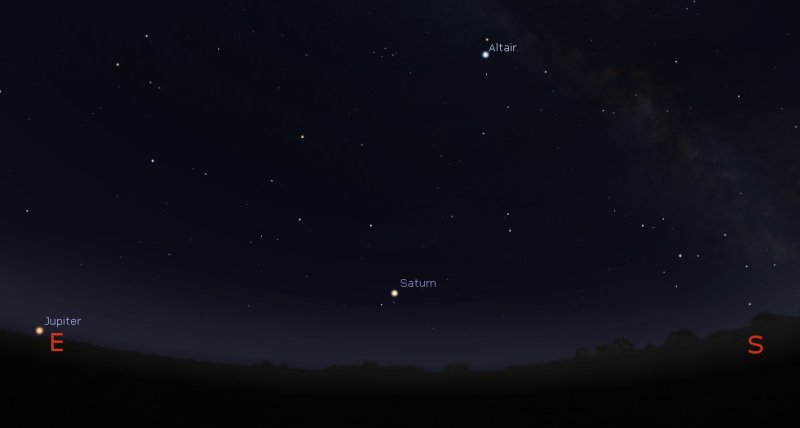 |
| |
|
The bright star Altair will be above Saturn.
It's important to realise that stars don't twinkle and the light radiating
from them is a relatively constant source. But then if you look at Altair,
I bet you will notice it twinkling-away like a good 'un. That's only
because the light is being twisted by our atmosphere. The higher an object
is in the night sky then the less atmosphere its light has to travel through
and so the effects are lessened. |
| |
|
If you stay up until around 1am, everything
will appear to have rotated around and Saturn will be more towards the
south, with Jupiter towards the south east. Of course they haven't really
moved - it's us that has rotated as the Earth spins on its axis! The Moon
will have risen above the horizon close to Jupiter and Mars will have popped
up a little north of due east. |
| |
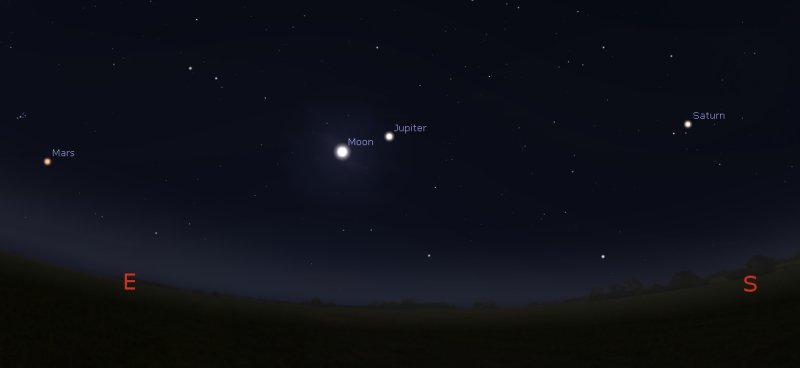 |
| |
|
Go outside at the same time on subsequent
evenings during the week and the planets will appear to be in a similar
position, but not the Moon as it is following a completely different path -
orbiting around us. At 1am on Saturday 20th, the Moon will appear to be in
the east, forming an isosceles triangle with Mars and the Pleiades cluster
of stars. |
| |
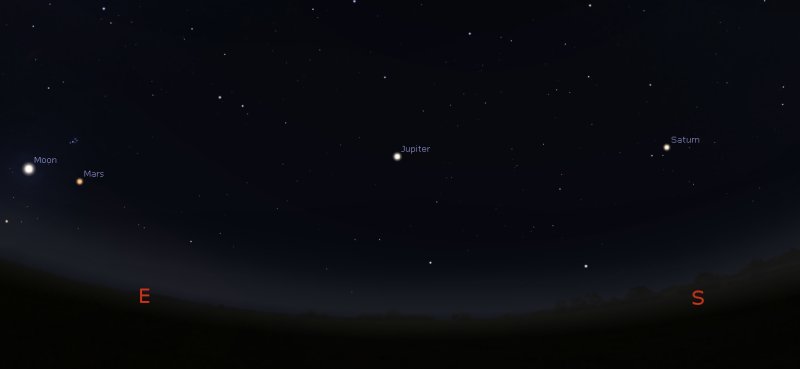 |
|
Monday 8th to
Sunday 14th August 2022 |
| |
|
On Friday 12th we have a Full Moon. Many of
the Lunar visual effects I have mentioned in the past require Sunlight to be
falling on the surface at an oblique angle, but some are better seen around
the time of a Full Moon and these are called Albedo Features. These large
features are so named because they have a high contrast with the area
surrounding them. One such example is what looks like a bright swirl called
Reiner Gamma located in Oceanus Procellarum or the Ocean of Storms.
|
| |
|
If you go outside around 11pm on 12th, the
Moon will be located towards the south east, with Saturn a little to the
right of it and Jupiter on the left looking more to the east. |
| |
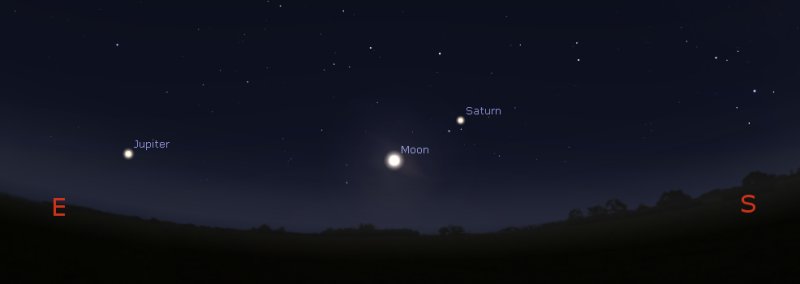 |
| |
|
Oceanus Procellarum is situated on the west
side of the Moon's face and I have included some diagrams below, courtesy of
Wikipedia, to help find the swirl. |
| |
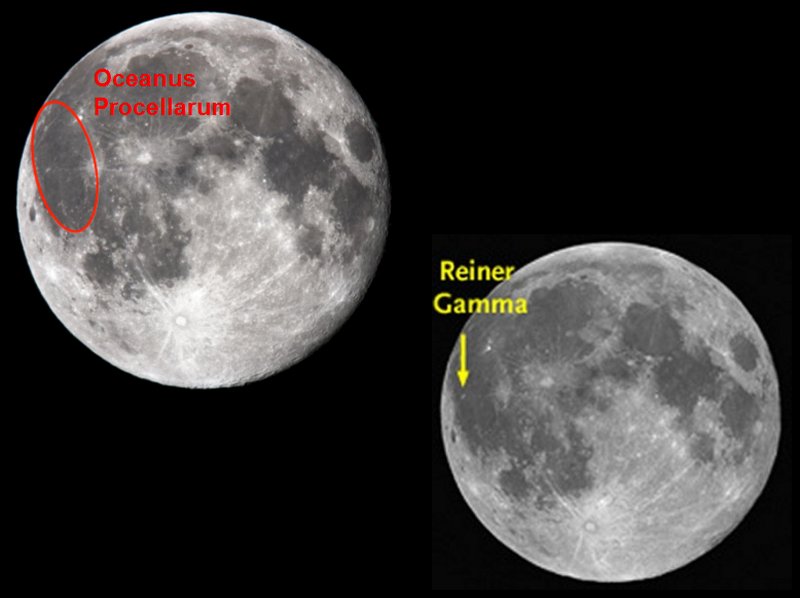 |
| |
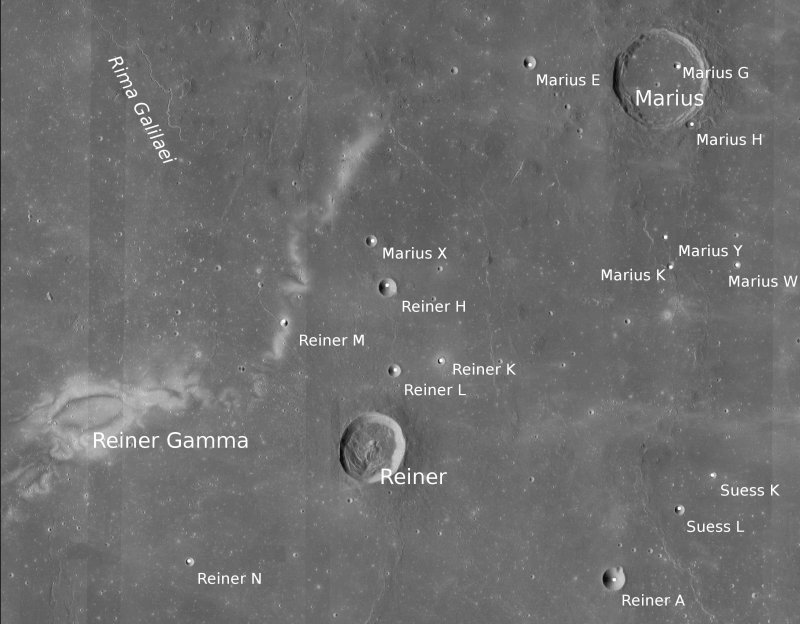 |
| |
|
The origin of Lunar Swirls is not fully
understood, but believed to be associated with magnetic activity. Several
robotic probes have landed in the Ocean of Storms, including Surveyor 3 in
1967. The Apollo 12 astronauts famously touched-down only 165m away from
Surveyor 3 a couple of years later and retrieved several items from it to
return to the Earth. |
| |
|
It will be necessary to use a telescope for a
good view of the Reiner Gamma swirl and at the same time, you could take a
look at Saturn's rings. Next week, Saturn is approaching a point in its
orbit called "opposition" when the Earth is directly between the planet and
the Sun. This gives the best opportunity to observe Saturn's rings as they
will be at their brightest. |
| |
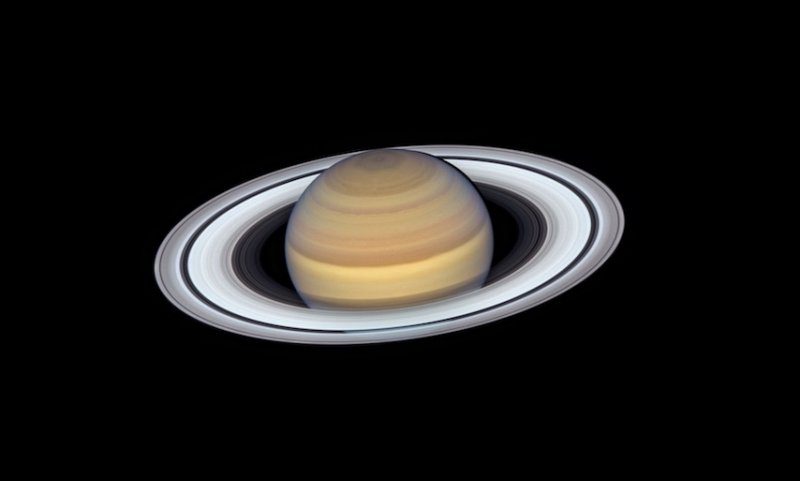 |
| |
|
Saturn image courtesy of NASA |
|
Monday 1st to
Sunday 7th August 2022 |
| |
|
Something a bit different this time. I often
give a dire warning about the dangers of attempting to look at the Sun
through binoculars or a telescope, but many astronomers do make successful
observations of our neighbouring star in complete safety. How do they
manage it? |
| |
|
The light you see originating from the Sun is
classed as "white light" which is a mixture of all the different wavelengths
or colours. A telescope for this is either fitted with a special filter in
front that stops virtually all the light from entering the tube in the first
place or a device called a Herschel wedge that bins most of the light
collected by the telescope before it can reach the eyepiece. White light
images are great for showing Sunspots - areas on the Sun's surface where the
temperature is considerably lower than the rest of it..........4000 degrees
Celsius as opposed to 5500 degrees! |
| |
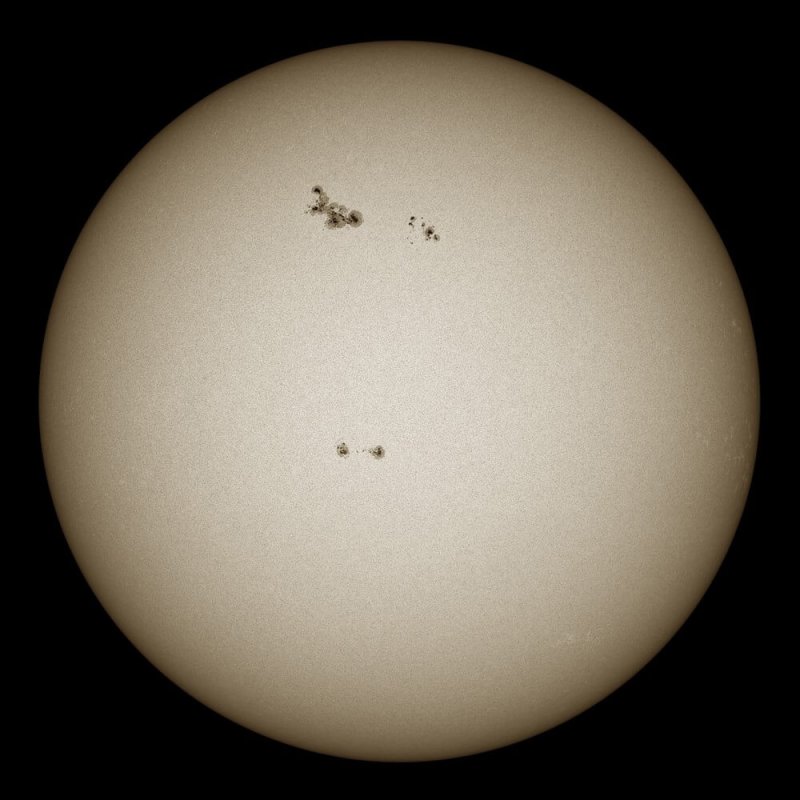 |
|
 |
| |
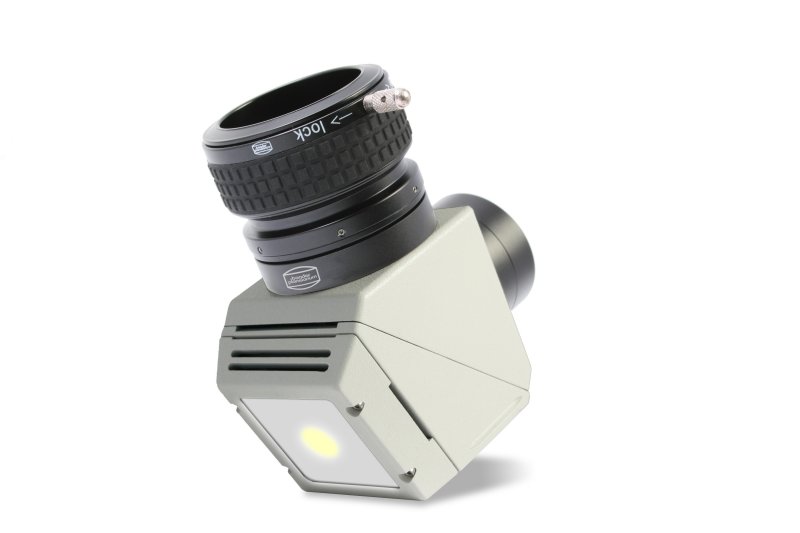 |
| |
|
A far more specialised type of telescope
focuses on just the red wavelength of light given off by Hydrogen burning
and these Hydrogen Alpha telescopes show stunning prominences or flares
flying off the Sun's surface in real time. White light images are just too
bright to show these prominences as the amount of light washes out the
detail. |
| |
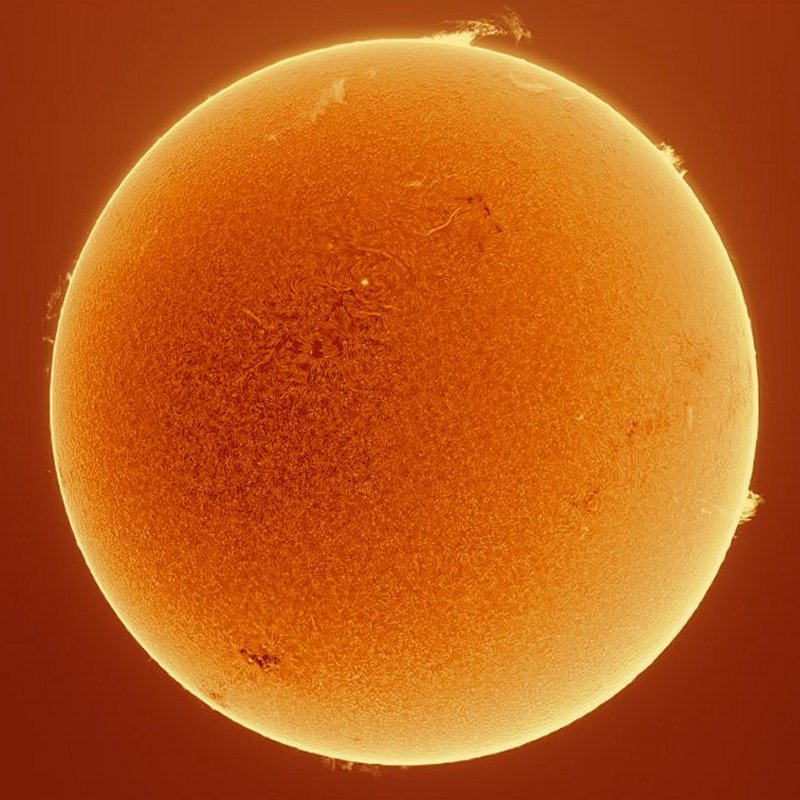 |
| |
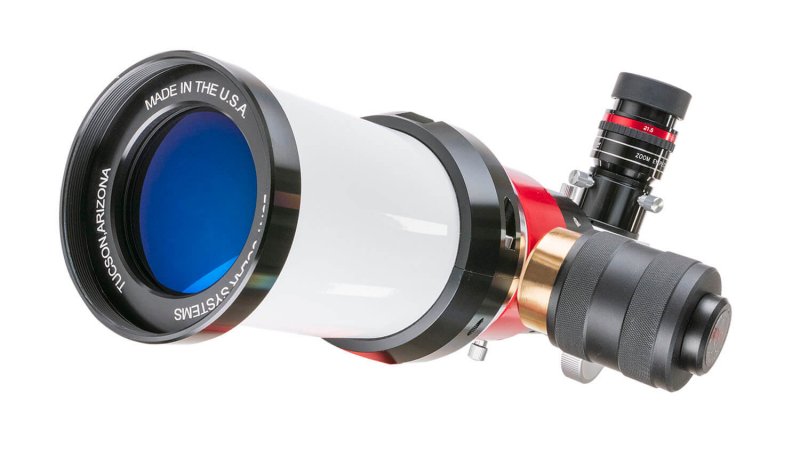 |
| |
|
If you'd like to witness all this for
yourself, I am running some "Daytime Astronomy" sessions with my Solar
telescopes at Braeside House in Devizes during their Family Day on Saturday
August 6th. Why not come along - entry is free and there are all sorts of
crafts, activities and even a hog roast! To find the details,
please visit
Braeside
Education Centre |
| |
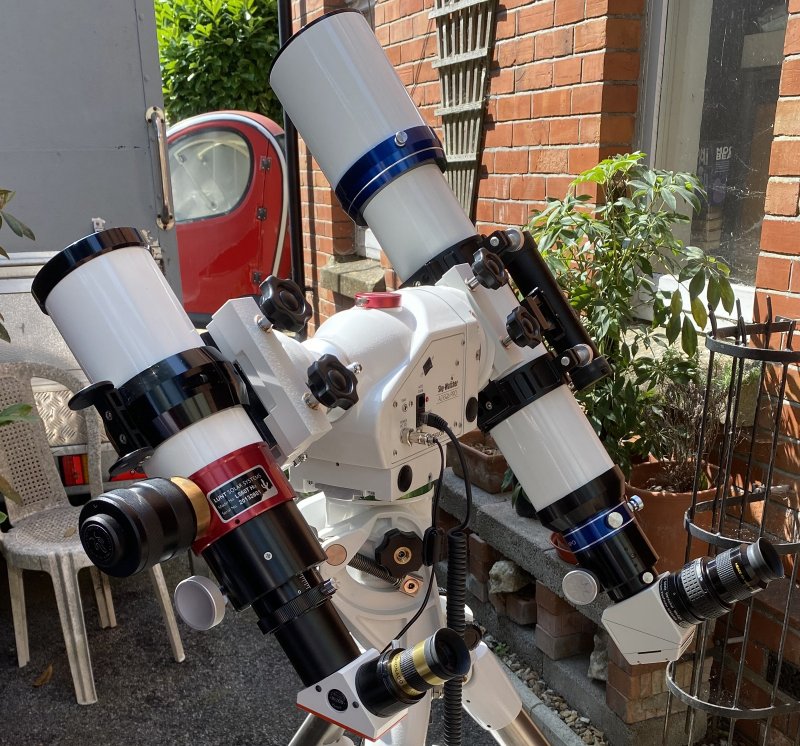 |
| |
 |
| |
|
Sun images courtesy of Lunt
Telescopes |






























